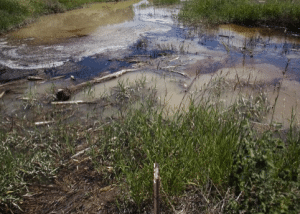 Exxon is still fumbling to deal with a 42,000-gallon oil pipeline spill on the Yellowstone River west of Billings, Montana. Its initial response was pathetic–it was slow to turn off the gushing pipeline, had no plan for dealing with a spill in high water (i.e. every spring) and, most alarmingly, “misspoke” about how deeply the pipe was buried in the riverbed, even denying a shortly before the spill that the pipe could be damaged by water erosion.
Exxon is still fumbling to deal with a 42,000-gallon oil pipeline spill on the Yellowstone River west of Billings, Montana. Its initial response was pathetic–it was slow to turn off the gushing pipeline, had no plan for dealing with a spill in high water (i.e. every spring) and, most alarmingly, “misspoke” about how deeply the pipe was buried in the riverbed, even denying a shortly before the spill that the pipe could be damaged by water erosion.
From the Associated Press:
Officials in Laurel, near the site of the spill, raised questions last year about erosion along the riverbank threatening the Exxon Mobil line. The company in December surveyed the pipe’s depth and said it was at least 5 to 8 feet beneath the riverbed.
The line was temporarily shut down in May after Laurel officials again raised concerns that it could be at risk as the Yellowstone started to rise. The company restarted the line after a day, following a review of its safety record.
The company said in a June 1 email — just a month before the spill — that the line was buried at least 12 feet beneath the riverbed, according to documents from the U.S. Department of Transportation, which oversees pipelines.
There’s lots more: it doesn’t have a plan or a timeframe for fixing the pipeline. It has no plan yet for how it will restore land along the scenic, wild river that provides water for crops, humans and the wildlife of Yellowstone National Park. It has no idea where the erroneous “12 feet” figure in an official Exxon document came from. And its statement that the oil would only affect 10 miles of river was off–now by a factor of more than four.
At least the spill won’t hurt Exxon’s tens of billions of dollars in yearly earnings. Whew. That’s a relief. It means the company can put a couple of high-powered PR people in charge of telling us how its response to a relatively piddling spill in Montana doesn’t mean it would completely blow the response to a major spill of several million gallons, like BP’s well in the Gulf. And how nothing like that could ever happen to a major Exxon well or pipeline. And how Exxon would respond vigorously to the next safety warning about one of its facilities.


